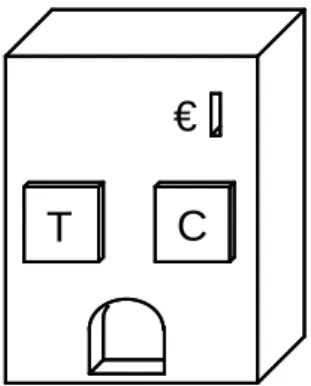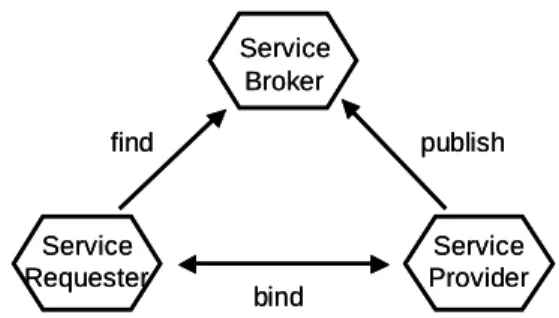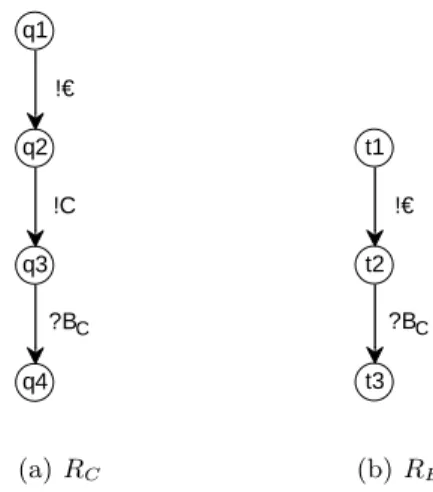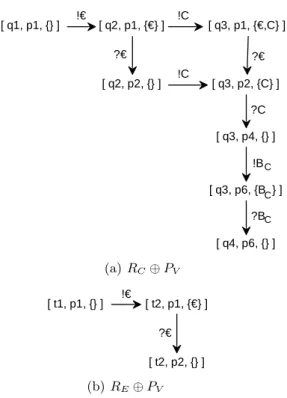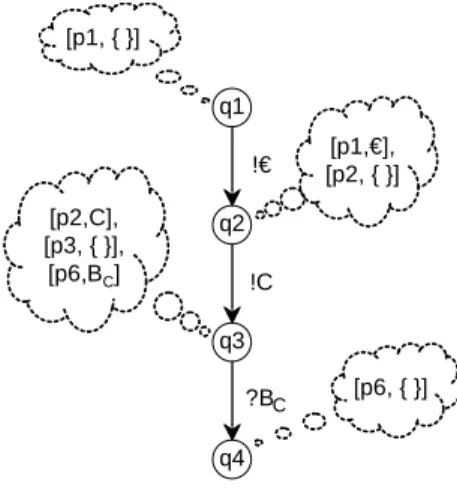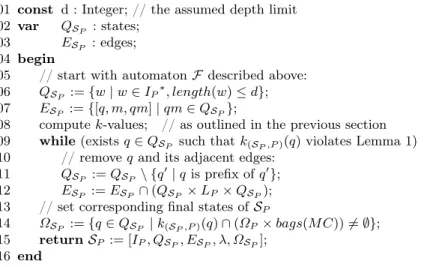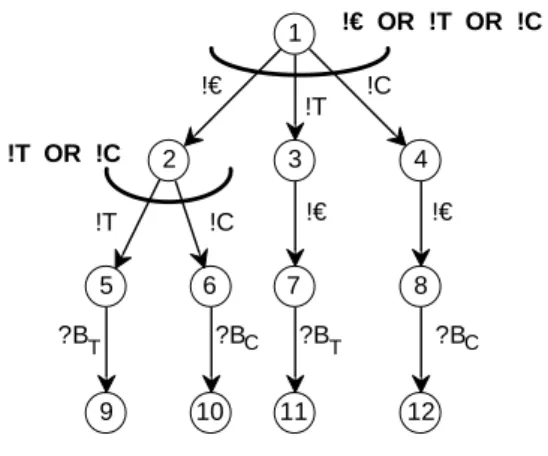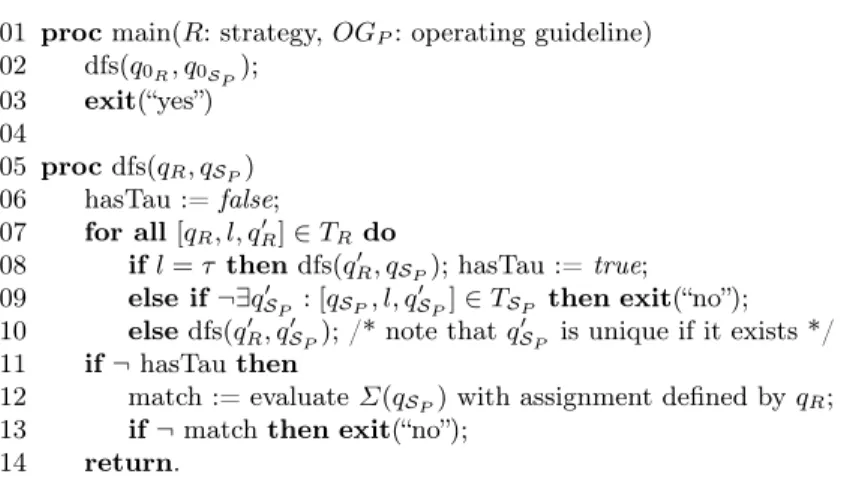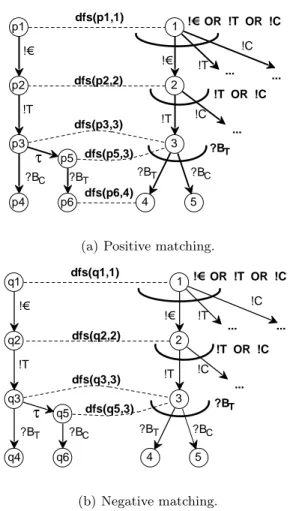An Algorithm for Matching Nondeterministic Services with Operating Guidelines
Peter Massuthe1 and Karsten Wolf2
1 Humboldt–Universität zu Berlin Institut für Informatik
Unter den Linden 6 10099 Berlin, Germany massuthe@informatik.hu-berlin.de
2 Universität Rostock Institut für Informatik 18051 Rostock, Germany karsten.wolf@uni-rostock.de
Abstract. Interorganizational cooperation is more and more organized by the paradigm ofservices.Service-oriented architectures(SOA) provide a general framework for service interaction. SOA describe three roles of services, theservice provider, theservice requester, and theservice broker, together with the three operationspublish,find, andbind.
We provide a formal method based on nondeterministic automata to model services and their interaction. In this paper, we restrict ourselves to finite and acyclic automata. We suggestoperating guidelinesas a con- venient and intuitive artifact to realize thepublishoperation. In our ap- proach, thefind operation reduces to a matching problem between the requester’s service and the published operating guidelines. If matching services are actually bound together, our approach guarantees deadlock- free communication. In this paper, matching of deterministic as well as nondeterministic automata with operating guidelines is presented.
Key words:Services, SOA, Formal Methods, (Nondeterministic) Automata, Operating guidelines, Matching
1 Introduction
Nowadays, cooperation across borders of enterprises is increasingly important.
Functionalities are outsourced or so-called virtual enterprises for specific tasks are formed. In this setting,services play an important role. A service basically encapsulates self-contained functions that interact through a well-defined inter- face. Recent publications apply the term service in different contexts with varying denotations (see [1] for a survey). In this paper, we assume the essentials of a service to include itsidentifier(id), itsinterface, and its internaloperational be- havior. We abstract from other aspects of services such as real-time constraints, cost models, underlying middleware, etc.
The well-known class ofweb services is an implementation of services with an interface specified in WSDL (Web Services Description Language) [2] and an id given by an URI (Uniform Resource Identifier).
In the following, we concentrate on services with operational behavior de- scribed as aworkflow, i.e. an implementedbusiness process. Such services have become particularly important since the establishment of BPEL3 as a widely accepted language to describe web services. BPEL provides control structures that typically occur in workflows.
As a running example we consider the service of a beverage vending machine as outlined in Fig. 1. The service provided by this machine expects a coin (C–– ) to be inserted and one of the buttonsTorCbeing pressed. The service then reacts by delivering a beverage, i.e. a cup of tea (in caseT has been pressed) or a cup of coffee (in caseChas been pressed).
T C
€
Fig. 1.A vending machine that sells, for1Euro, either a cup of tea (buttonT), or a cup of coffee (buttonC).
Typically, a service is not executed in isolation, but in cooperation with other services. So, a network of interacting services arises. Service-oriented ar- chitectures (SOA) [4] provide a general framework for service interaction. SOA distinguish three roles of services: theservice provider, theservice requester, and the service broker. A service provider publishes information about his service to a repository. The service broker manages the repository and allows a service requester tofind an adequate service provider. Then, the requester may initiate thebindoperation and both service requester and provider can start interacting.
The three roles of services and the three operationspublish, find, and bind are depicted in Fig. 2.
The interaction of services may cause nontrivial communication between a requester and a provider. In our example, a requester of the vending machine service must insert a coin, press a button, and will finally receive his beverage.
3 Business Process Execution Language for Web Services[3], also known as BPEL4WS or WS-BPEL.
Service Broker
Service Provider Service
Requester
publish find
bind Service
Broker
Service Provider Service
Requester
publish find
bind
Fig. 2.The service-oriented architecture triangle.
Considering the service broker, it is obviously desirable that a querying ser- vice requester gets assigned only such a service provider that their services do not ill-communicate with each other (such as running into a deadlock or sending unanticipated messages).
In our example, a broker must not deliver our vending machine service to a requester who wants to pay in other currencies than–– or to a requester whoC expects the beverage before paying.
For this purpose, the service broker needs information about the internal control structure of the provider’s service – the service’s interface only (like its WSDL specification, for instance) is not sufficient. Publishing the whole internal control to the service broker would solve the problem. This is, however, not feasible for complexity reasons. Additionally, the service provider may want to keep the internal structure of his service secret.
In a currently quite popular approach, the information published about a provider’s serviceP is a so-calledpublic view [5,6] ofP, i.e. an abstract version P0 with a communication behavior equivalent toP. In this setting, the broker must perform a compliance check, i.e. a check whether the system composed of P0 and a requesting serviceR behaves well in the above described manner.
The compliance check is mainly a verification task for the (non-)reachability of states in the composed system. It is supposed that compliance of R and P0 induces compliance of RandP.
In contrast, our approach is based on a different perspective: A provider does not publish information about internals ofhis serviceP, but information about all accepted ways ofinteractingwithP. This information implicitly describes all well-communicating requester’s servicesRforP and is calledoperating guideline forP (OGP for short) [7,8].
In our operating guideline setting, the broker must solve amatching problem.
If a requester’s serviceRmatchesOGP thenR’s interaction withP is accepted.
Thus, it is guaranteed thatP andRinteract well.
As an advantage, matchingRwith OGP is less complex than a compliance check ofRwith the public viewP0ofP: The complexity of the compliance check is in the order of theproductof the sizes ofRandP0. In contrast, the complexity of matchingR withOGP is basically in the order of the size of Ronly.
In this paper, we present a formal approach to realize a service-oriented architecture with the help of operating guidelines. In its current shape, it is restricted to acyclic services, i.e. services which cannot return to a state they have been in before. In our approach, a service is modeled as an acyclic, possibly nondeterministicservice automaton. A possible way of interacting with a service is modeled as an automaton as well.
We establish a theory that enables us to characterizeallaccepted interactions Rwith a given serviceP. Our main result in this regard is the separation of the criterion “accepted behavior” into local conditions which, for every statesofR, just talk about presence or absence of transitions leaving s. These conditions can be translated into Boolean annotations to a particular automaton SP for characterizing the set of all accepted interactions with P. The annotated SP
then serves as the operating guideline.
The rest of the paper is organized as follows. First we introduce our formal foundation for services, service automata, and their interaction via asynchronous communication in Sect. 2. Then, in Sect. 3 we formally define the operating guideline for a service automaton and develop an algorithm to compute op- erating guidelines. In Sect. 4 we show how operating guidelines can be used to derive all well-communicating service requesters for a given provider. We present an algorithm to match both deterministic and nondeterministic automata with operating guidelines. Finally, we summarize the results of the paper and sketch our plans for further work.
2 A Formal Model for Services
In this section we introduce service automata, a class of communicating, non- deterministic automata, as a formal model for services. A service automaton reflects the internal control of a service as well as its communication behavior via its interface. Service automata provide a model for services of requesters and providers.
Service automata are essentially a simplification of classical I/O automata [9]
towards the handling of asynchronous messages. Using I/O automata, the con- tent of mailboxes and message channels would be modeled explicitly as part of the state of an automaton. In our approach, the mailboxes are not considered to be part of the automaton itself. They occur implicitly through the definition of the interaction between service automata. This approach leads to smaller and thus more readable automata. Other versions of automata models for services were proposed by [10] and [1], for instance. In [10] communication is modeled as occurrences of labels with no explicit representation of pending messages, whereas [1] use bounded and unbounded queues to store such messages.
In our service automata model the communication behavior of a service is modeled as labels to transitions of the service automaton. A label!xrepresents sending a message via channelx(which can represent a message or a real trade item). In contrast, a label ?x represents receiving a message from channel x.
The labelτ represents a silent (i.e. internal) transition. We require that, inside
one and the same automaton, a letterxoccurs either everywhere with question mark or everywhere with exclamation mark. For the sake of simplicity, we ab- stract from data and do not consider the content of a message. For data with finite domain, important message content can, however, be represented in our ap- proach. For instance, a message with Boolean values can be represented through the separation into two channels, one for messages with content true, one for messages with content false.
The interaction of services is represented by a composite transition system of the corresponding service automata. A state of the transition system consists of a state of each communicating service automaton and the currently pending messages. Well-communication of two servicesR and P is then expressed as a property of the transition system.
In the following, we assume a finite setM C of message channels.
Definition 1 (Service automaton). Aservice automaton is a nondetermin- istic automatonA= [I, Q, T, q0, Ω] that consists of
• an interfaceI=Iin∪Iout such that Iin, Iout⊆M C,Iin∩Iout =∅,
• a finite setQ ofstates,
• a finite setT ⊆Q×L×Q of transitions where L={?x|x∈Iin} ∪ {!x| x∈Iout} ∪ {τ},
• aninitial stateq0∈Q, and
• a setΩ⊆Qof final states.
Lis called the set oflabelsof A. y
In the sequel, we studyacyclicservice automata only, i.e. automata such that the transitive closure of the transition relation is irreflexive.
We denote service automata by A, B, P, and R. A and B are used for arbitrary automata, P and R are used if we want to emphasize the role as service provider and service requester, respectively. If not clear from the context, we denote the ingredients of a service automatonAbyIA,IinA,IoutA,QA,TA, q0A,ΩA.
As an example, Fig. 3 shows a service automatonPV modeling the vending machine of Fig. 1. The automaton can receive a coin (label?C–– ) and accepts one of the two buttons being pressed (labels?Tand?C). The vending machine then generates a beverage (labels!BC and!BT). Letp1 be the initial state ofPV and letp5andp6be the final states ofPV.
Consider now two requesters who want to use the provided vending machine service. Their services are modeled as service automata RC and RE, depicted in Fig. 4. Let q4 and t3 be the only final states of RC and RE, respectively.
RC models a customer who wants coffee, whereas the customer modeled by RE apparently “forgets” to press one of the buttons. Thus, RE is an erroneous customer of the vending machine.
Two communicating automataR and P must have interfaces such that one automaton sends only those messages that can be received by the other one, and vice versa. Without loss of generality, we assume IinR=IoutP andIoutR =IinP
to be given from now on.
p1
p2
p3
p5
p4
p6
?€
?C
?T
!BT !BC
Fig. 3.A service automatonPV for the provider’s vending machine.
q1
q2
q3
q4
!€
!C
?BC
(a)RC
t1
t2
t3
!€
?BC
(b)RE
Fig. 4.Two service automataRCandREmodeling requesters of the vending machine.
We consider an asynchronous model of message passing betweenR and P. This model is formalized through the following definition of the transition system R⊕P representing the behavior of two service automata in interaction. As we assume asynchronous communication, this interaction involves messages pending in channels (namely those which have already been sent but not yet received).
Since more than one message of a kind may be pending, we use the concept of multisetsfor modeling pending messages. A multiset is basically an extension of the conceptsetwhich allows multiple occurrences of one and the same element.
Formally, a multiset over a domainA is a mappingM :A→N. M(a)is called the multiplicity of a in M and stands for the number of occurrences of a. In all following definitions,bags(A)denotes the set of all multisets overA.M +a stands for incrementing the multiplicity ofa in M by1 (adding an element to M), and M−afor decrementing the multiplicity of ainM by1(removing an
element from M).a∈M is true if the multiplicity of ain M is at least1. We use{}to denote the empty multiset where, for alla∈A,{}(a) = 0.
A state of the transition systemR⊕P represents a state ofP, a state ofR, and a multiset M of pending messages. Every transition ofR⊕P corresponds either to a transition inRor to a transition inP. A transition labeled!aproduces a message in channela, whereas a transition labeled?aconsumes a message from channelawhich can only occur ifais present in the message bag.τ-transitions do neither create nor consume messages.
Definition 2 (Interaction of service automata). Let P and R be two ser- vice automata. Without loss of generality, let QR∩QP = ∅. The transition systemR⊕P = [Q, T, q0, Ω]consists of
• a set of statesQ⊆QR×QP×bags(M C),
• a set of labeled transitionsT ⊆Q×(LP∪LR)×Q,
• an initial stateq0, and
• a setΩ⊆Qof final states.
QandT are defined inductively as follows:
Basis: q0= [q0R, q0P,{}] is a state of the transition system.
Step: Ifq= [qR, qP, M] is a state and there is a transition
• t= [qR,!a, q0R]∈TR, thenq0= [q0R, qP, M+a]∈Qand[q,!a, q0]∈T,
• t= [qP,!a, q0P]∈TP, thenq0= [qR, qP0 , M+a]∈Q and[q,!a, q0]∈T,
• t = [qR,?a, qR0 ] ∈ TR and a ∈ M, then q0 = [qR0 , qP, M −a] ∈ Q and [q,?a, q0]∈T,
• t = [qP,?a, q0P] ∈ TP and a ∈ M, then q0 = [qR, qP0 , M −a] ∈ Q and [q,?a, q0]∈T,
• t= [qR, τ, q0R]∈TR, thenq0= [q0R, qP, M]∈Qand[q, τ, q0]∈T,
• t= [qP, τ, qP0 ]∈TP, thenq0 = [qR, qP0 , M]∈Qand[q, τ, q0]∈T.
A stateq= [qR, qP, M]of R⊕P is defined to be a final state, i.e.q∈Ω, if
and only ifqP ∈ΩP,qR∈ΩR, andM ={}. y
The definition formalizes the intuition thatRand P move independently in R⊕P. A receive action is only possible if the message to be received is present in the message bag (it is then removed). A send action adds a message to the bag.
As an example, the transition systemsRC⊕PV and RE⊕PV are depicted in Fig. 5. The node[q1, p1, {}]in the transition system in Fig. 5(a) means that the coffee requesterRC of Fig. 4(a) is in its stateq1, the vending machinePV is in its statep1, and there are no messages pending. Since it was possible for the requester to send a coin in stateq1, it is possible in[q1, p1, {}], too. Thereby, a new node is reached, where the requester is in stateq2and there is an–– pendingC to be consumed by the vending machine.
In this paper, we concentrate on a correctness criterion calledweak termina- tion. Intuitively, weak termination means that from every reachable state of the
[ q1, p1, {} ] [ q2, p1, {€} ] [ q3, p1, {€,C} ]
[ q2, p2, {} ] [ q3, p2, {C} ]
[ q3, p4, {} ]
[ q3, p6, {B } ]
[ q4, p6, {} ]
!€ !C
!C
?€ ?€
?C
!BC
?BC C
(a)RC⊕PV
[ t1, p1, {} ] [ t2, p1, {€} ]
[ t2, p2, {} ]
!€
?€
(b)RE⊕PV
Fig. 5.The two transitions systemsRC⊕PV andRE⊕PV.
transition system a final state of the transition system is reachable. This crite- rion is derived from the notion ofweak soundness of components of distributed workflows [6]. Weak soundness itself is based on the notion of soundness of (monolithic) workflows introduced by van der Aalst [11].
Definition 3 (Deadlocks, weak termination). Let P and Qbe two acyclic service automata and letP⊕Rbe the corresponding transition system as defined above. A non-final state q, i.e. q∈Q\Ω, without any successor inR⊕P is a deadlock.P⊕R isweakly terminatingiffR⊕P does not have deadlocks. y It is easy to see that the only state without successors inRC⊕PV is the state[q4,p6,{}], which is a final state ofRC⊕PV: Fig. 5(a) is an example of a transition system which is weakly terminating.
In contrast, the state[t2,p2,{}]of the transition systemRE⊕PV (see Fig. 5(b)) is a deadlock but is no final state: RE⊕PV isnot weakly terminating.
In this paper, for a given service automatonP, we are interested in the set of allservice automataRsuch that the composed system ofRandP behaves well.
In technical terms, we are looking for all R, s.t. R⊕P is weakly terminating.
Each suchRis called astrategy forP.
Definition 4 (Strategy). Let P be a service automaton. A service automaton R is astrategyforP iffR⊕P is weakly terminating. y
In our example,RC is a strategy forPV butRE is no strategy forPV. The term strategy originates from a control-theoretic point of view (see [12,13], for instance): We may seeRas a controller forP enforcing the weak termination property.
From now on, a service automaton is denoted byS if we want to emphasize its role as a strategy. The set of all strategies forP is denoted byStrat(P).
Several results in the forthcoming sections are based on a state-by-state char- acterization of those service automata which are strategies. This characterization uses a mapping that we callknowledge.
Definition 5 (Knowledge). LetRandP be two service automata. The knowl- edge functionk(R,P)is a mappingk(R,P):QR→℘(QP×bags(M C)), such that
k(R,P)(qR) ={[qP, M]|[qR, qP, M]∈QR⊕P}. y
Informally,k(R,P)(qR)represents the set of possible states inR⊕P that P and the message bag can be in, whileRis in qR.
For given servicesR and P,k(R,P) can be easily computed by constructing R⊕P. This is possible in time proportional to the size of R⊕P which is at most the size ofRtimes the size ofP. For acyclic servicesR,k(R,P)can as well be computed incrementally since the valuek(R,P)(q)just depends on the direct predecessors ofqin R.
q1
q2
q3
q4
!€
!C
?BC [p6, { }]
[p1, { }]
[p1,€], [p2, { }]
[p2,C], [p3, { }], [p6,BC]
Fig. 6.The service automatonRC with its knowledge about the vending machine.
Figure 6 shows the coffee requester’s serviceRC of Fig. 4(a) with itsk-values depicted in the bubbles. IfRC is in state q1then PV must be in state p1 and the message bag is empty, hencek(RC,PV)(q1) ={[p1,{}]}. After sending a coin (i.e.RC is in stateq2),PV can still be in statep1and the coin is in the bag, or PV has already received the payment and is in statep2.
Using the knowledgek(R,P), we can characterize strategies as follows.
Lemma 1. Ris a strategy forPiff, for allqR∈QRand all[qP, M]∈k(R,P)(qR), at least one of the following conditions holds:
• qR∈ΩR,qP ∈ΩP, andM ={}, i.e.[qR, qP, M] is a final state;
• there is a transitiont = [qP, l, qP0 ] in TP, such that there is a transition in R⊕P that leaves [qR, qP, M] and is labeled withl;
• there is a transitiont = [qR, l, qR0 ] in TR, such that there is a transition in R⊕P that leaves [qR, qP, M] and is labeled withl. y We omit the proof since the result is basically a reformulation of the defini- tion of weak termination. Nevertheless, the lemma shall turn out to be useful since it describes explicitly the obligations for strategiesR: WheneverP has no transition leaving a state inR⊕P (which is determined since we assumeP to be given) thenRis obliged to have one (i.e. we have to design Rsuch that it is capable of leaving such states).
It is again easy to check the service automataRC andRE for these criteria.
Whereas RC fulfills Lemma 1, RE violates all three criteria in state t2: There is a tuple [p2,{}] in k(RE,PV)(t2) such that neither [t2,p2,{}] is an end state, nor is there a transition possible inRE⊕PV: All transitions leavingt2(p2) are consuming transitions in RE (PV), butM is empty.
3 Operating Guidelines
In this section, we develop our notion of operating guidelines. An operating guideline for a service P is an artifact computed from P that is suitable for deciding for arbitrary servicesR, whether or notRis a strategy forP. In other words, our aim is to characterize the set of all strategies Strat(P). In our ap- proach, the operating guideline OGP for a service P will turn out to be an annotated automaton. It is built from a specific strategySP and Boolean anno- tations as in [14]. The strategy SP as well as the annotations are selected such that a deterministic automaton is a strategy for P if and only if it is a sub- automaton ofSP that complies to the annotations in a sense yet to be defined.
The case of nondeterministic requesters is left to the next section.
A service automaton (and thus a strategy) is deterministic if it does not containτ-transitions and does not have states that are left by multiple transitions with equal labels. The set of all deterministic strategies of P is denoted by Stratd(P). Obviously, it holds Stratd(P)⊆Strat(P).
We proceed as follows. We formally define the notions sub-automaton, an- notation, and compliance. Then we exhibit, based on Lemma 1, the particular strategySP as well as the particular annotations that form the operating guide- lineOGP for a given serviceP. We conclude with an algorithm and remarks on complexity issues.
Definition 6 (Sub-automaton). An automatonA0 is a sub-automaton of an automaton A, A0 v A, iff QA0 ⊆ QA, TA0 ⊆ TA, q0A0 = q0A, and ΩA0 ⊇
QA0∩ΩA. y
The set of all sub-automata of an automatonA is denoted bySub(A).
If P is acyclic, we may unroll every deterministic strategy R of P to an equivalent strategyR0which is atree shaped automaton, i.e. a service automaton where each state has at most one incoming transition. Since P is acyclic, R0 has limited depth. Thus, matching non-tree-shaped automata withOGP can be reduced to matching tree shaped automata with OGP. It is thus sufficient to characterize the set Stratd,t(P)⊂Stratd(P) of all (deterministic) tree shaped automata which are strategies for P.
Consider a deterministic tree shaped automaton A and a function Φ that maps every stateqofAto a Boolean formulaΦ(q). Let the propositions ofΦ(q) be labels of transitions that leave qin A. Φis then called an annotation to A.
An automaton with an annotation is calledannotated automatonand is denoted byAΦ. As an example, Figure 8 shows an annotated automaton.
Definition 7 (Φ-compliance). LetAΦ be an annotated automaton,A0 a sub- automaton ofA, andq∈QA0 (and thereforeq∈QA).
A stateqiscompliant withΦ(q)iffΦ(q)istrueunder the assignment assigning trueto all propositions that are labels of transitions leavingqinA0, and falseto all other propositions.
A0 iscompliantwithAΦ (denotedA0 |=AΦ) iff all statesq∈QA0 are compliant
with Φ(q). y
Having a compliant sub-automatonA0ofA, we call every automatonA00that is isomorphic toA0 compliant toAΦ, too.
LetComply(AΦ) ={A0 |A0 vA, A0 |=AΦ} denote the set of all automata that are compliant toAΦ. This way, a single annotated automatonAΦrepresents a set of automata, i.e. the setComply(AΦ).
Our goal for the remaining part of this section is to derive an automatonSP
and an annotation Σ such that Comply(SPΣ) = Stratd,t(P). We will then use SPΣ as the operating guideline forP. Both our choice ofSP andΣ depends on Lemma 1 presented at the end of the previous section.
Let, throughout the remainder of this section, P be a service automaton.
First, we derive a suitable automatonSP. Since only sub-automata can be com- pliant with SP, SP must be at least as large as the largest deterministic tree shaped strategy of P. As pointed out earlier, there is a depth limit dfor deter- ministic interaction withP. Furthermore, a deterministic tree shaped automaton can have, in every state, at most one transition per message channel. Thus, every deterministic tree shaped strategy must be a sub-automaton of the automatonF which is a tree of sufficient depth where all states at non-maximum depth have exactlyone successor for each message channel. SinceF may become as large as cd where c is the number of message channels ofP anddthe depth limit, it is desirable to find a smaller automaton that fits our needs. Such an automatonSP
can be found by applying Lemma 1 toF. The following pseudo-code algorithm illustrates the idea. It first computesFand then iteratively removes states which violate Lemma 1. The result is the service automatonSP. In this algorithm, we encode a state ofF as a sequence over message channels. This results in unique
naming of states. The initial state is coded as the empty sequence λ, the suc- cessor of state q reached by the transition labeledm is denoted by qm. Let I∗ denote the set of finite sequences overI.
01 const d : Integer; // the assumed depth limit 02 var QSP : states;
03 ESP : edges;
04 begin
05 // start with automatonF described above:
06 QSP :={w|w∈IP∗, length(w)≤d};
07 ESP :={[q, m, qm]|qm∈QSP};
08 computek-values; // as outlined in the previous section 09 while(existsq∈QSP such thatk(SP,P)(q)violates Lemma 1) 10 // removeq and its adjacent edges:
11 QSP :=QSP\ {q0|qis prefix ofq0};
12 ESP :=ESP ∩(QSP×LP×QSP);
13 // set corresponding final states ofSP
14 ΩSP :={q∈QSP |k(SP,P)(q)∩(ΩP×bags(M C))6=∅};
15 returnSP := [IP, QSP, ESP, λ, ΩSP];
16 end
Fig. 7.The algorithm for constructing the strategy SP out ofF by removing states violating Lemma 1.
Since, by Lemma 1, states being removed by this procedure cannot be a member of any strategy of P, we immediately have, that every deterministic tree shaped strategy of P is a sub-automaton of the resulting automaton SP. Formally:
Lemma 2. Stratd,t(P)⊆Sub(SP). y
Justified by this lemma, we shall refer to the computed SP as the most permissive (tree shaped) strategyforP.
The outlined algorithm involves starting out with the automatonF. This can be substantially improved by constructing and k-annotating F incrementally.
This way, it is not necessary to descend beyond states that violate Lemma 1 anyway. This idea has been detailed out in [15].
In the next step, we aim at constructing a particular annotation Σ to an arbitrary tree shaped automatonRsuch thatComply(RΣ)is exactly the set of those sub-automata ofRwhich are inStratd,t(P). For this purpose, letqR∈QR. Then the formulaΣ(qR)is built as a straight coding of the criteria in Lemma 1:
Σ(qR)is theconjunctionof sub-formulaeσ(qR,qP,M), for all[qP, M]∈k(R,P)(qR).
Ifk(R,P)(qR) =∅then letΣ(qR) =true.
The sub-formulaσ(qR,qP,M) is
• trueifqR∈ΩR, qP ∈ΩP, andM ={};
• trueif there is a transition ofP leaving[qR, qP, M]in R⊕P;
• the disjunction of all l occurring as labels of transitions in R that leave [qR, qP, M]in R⊕P, otherwise.
Please note that if there is nolin the third item, thenσ(qR,qP,M)is the empty disjunction which is equivalent tof alse.
Lemma 3. Let R,P,Σ be as described above. ThenComply(RΣ)is the set of those sub-automata of Rwhich are in Stratd,t(P). y Proof (Sketch). For a tree shaped automatonR and a sub-automaton R0 it is easy to verify that, for all q ∈ QR0, k(R0,P)(q) = k(R,P)(q). Then, by the construction of Σ, R0 ∈Comply(RΣ) iff every state of R0 satisfies the criteria
stated in Lemma 1. ¤
Combining the previous two lemmas, we obtain:
Theorem 1 (Characterization of strategies). Let P be an arbitrary ser- vice automaton. Let SP be its most permissive strategy. Then, Comply(SPΣ) =
Stratd,t(P). y
Thus, the following definition of operating guidelines is justified:
Definition 8 (Operating guideline). Let P be an arbitrary service autom- aton. Let SP be its most permissive strategy. Let Σ be annotations to SP as described above. Then SPΣ is called theoperating guidelineOGP forP. y
1
3
5
9
8
12
!€
!T !C
!T !€
!€
!C
2 4
7
11 6
10
!€ OR !T OR !C
!T OR !C
?BC
?BC ?BT
?BT
Fig. 8.The operating guidelineOGPV for the vending machine service automatonPV.
As an example, we recall our vending machine service automatonPV. The operating guidelineOGPV forPV (Fig. 3) is depicted in Fig. 8. It is constructed
by removing states from the complete automaton of depth 3with labels!C–– ,!T,
!C,?BC, and?BTleaving each state. The annotation of a state with less than two successors is skipped since it coincides with the label of the outgoing transition (in case of one successor) or istrueif there are no successors.
It is easy to see that the service automatonRCof Fig. 4(a) is compliant with the annotations. The automatonREof Fig. 4(b), instead, is not compliant since its state t2 (which is corresponding to state 2 of OGPV) violates the formula attached to that state: There is no transition in RE leaving t2 that is labeled with!Tor!C.
ComputingOGP consists of first computing the most permissive strategySP
for P, and second computing the annotations for all states of SP. Computing SP can be done in timecd· |P|wherec is the number of message channels ofP, dis the maximum number of interactions in any run ofP, and|P|is the number of states of P. In one pass, the full automaton F of size cd is generated. In a second pass,F is annotated withk-values which takes|F| · |P|. In a third pass, states of F are removed if they violate Lemma 1. This can be done in a single depth-first search through F which is linear in |F|. The accumulated costs of investigating thek-values ofF is proportional to|F| · |P|. Thus, all passes need at mostcd· |P|. Computing the annotations takesc· |SP| · |P|. For every stateq ofSP, we need to traverse throughk(SP,P)(q)and build a disjunction of at most celements. Thus, the accumulated costs areO(c· |SP| · |P|). The computational efforts can be significantly reduced by the use of technologies known from the area of model checking. There, several powerful techniques for alleviating state explosion have been developed.
We propose to useOGP as an artifact generated by the owner of a provided serviceP which can be published to the service broker.
4 Matching Service Automata with OG
PIn the previous section, we proposed the operating guideline OGP = SPΣ as a characterization of all deterministic strategies for a given service automaton P, i.e. Stratd,t(P) = Comply(OGP). The result is a very easy check to find out whether a querying requester’s service R will weakly terminate with the provided serviceP. For adeterministicautomatonR, the broker must matchR with OGP and decide whether Ris an element of the set Comply(OGP). This can easily be done in two steps: First, the broker needs to check if Rv SP. If the test fails, thenRcan be no strategy. Otherwise the broker must, in a second step, check the compliance of R with the annotations, i.e. decide if R |= SPΣ. Only if both tests succeed,Ris a strategy. If at least one test fails,RandP are not weakly terminating and henceRis no strategy.
Thus, matching a deterministic service automatonR withOGP amounts to unrollingR to a tree, to map the nodes ofR to nodes ofOGP, and to evaluate the annotations inOGP. All steps can be performed during a single depth-first search through the unrolled version of Rand is thus linear in the size ofR.
A typical example of a requester that already fails in the first step is our vending machine requester RE (Fig. 4(b)) who forgets to press a button. It is easy to see that RE is no sub-automaton of the most permissive strategySPV
underlying the operating guidelineOGPV of our vending machine.
A requester who first inserts a coin and then presses the button for tea, but who then leaves his beverage in the machine is a typical example for failing in the second step of the matching process. The corresponding service automaton would be a sub-automaton ofSPV in the first step. In the second step, however, the automaton must have a transition labeled?BTto comply with the annotation of state5ofOGP – which is not present in the automaton.
In the rest of this section, we are interested in the matching of all strate- gies, including the nondeterministic ones. Fortunately, OGP is, without any change, capable of characterizing nondeterministic strategies, too. In the sequel, we present an algorithm that receives an arbitrary (deterministic or nondeter- ministic) acyclic service automatonRand the operating guidelineOGP ofP as input, and is capable of deciding whether R is a strategy for P or not. With- out loss of generality, we assume R to be given in its unrolled shape, i.e. as a tree shaped automaton. We proceed with presenting the algorithm, followed by a justification of its correctness.
Our algorithm is based on a coordinated depth-first traversal ofRandOGP. Let againSP be the most permissive strategy underlying the operating guideline OGP, i.e.OGP =SPΣ. Hence, a stateqSP is a state inOGP and a state qR is a state in R. The algorithm assigns, to each state qR in R, a “fitting” state qSP inOGP. Then, we evaluate the annotation of the assigned stateqSP under the assignment given by qR. Only those states of R that do not have leaving τ-transitions must be evaluated. We claim thatRis a strategy if and only if all executed evaluations yield true. This amounts to the following pseudo-code for our matching algorithm, depicted in Fig. 9.
The number of calls to dfs is at most the number of states ofR. Our algorithm is thus an efficient instrument for matching an acyclic service automatonRwith an operating guidelineOGP.
As an example, consider again our vending machine. The relevant part of its operating guideline is depicted on the right hand side of Fig. 10(a) and Fig. 10(b). Please note the state 5 of the operating guideline. This node will never be reached by any requester since the vending machinePV will not return a coffee after button T was pressed. Thus, the knowledge value k(5) is empty and the annotation of state 5 is equal to true. This node is not removed while constructing the operating guidelines (but was not shown in the figures before for reasons of better readability).
Consider now two new nondeterministic requesters of the vending machine.
The requester on the left hand side of Fig. 10(a) is capable of receiving a coffee or to internally decide for a tea in statep3. The call dfs(p3,3)results in hasTau being true and hence the formula Σ(3) = ?BT is not evaluated for p3. All executed evaluations in Fig. 10(a) yieldtrue. Thus, Fig. 10(a) is an example for positive matching.
01 procmain(R: strategy,OGP: operating guideline) 02 dfs(q0R, q0S
P);
03 exit(“yes”) 04
05 procdfs(qR, qSP) 06 hasTau :=false;
07 for all[qR, l, qR0 ]∈TR do
08 ifl=τ thendfs(qR0, qSP); hasTau :=true;
09 else if¬∃qS0P : [qSP, l, q0SP]∈TSP then exit(“no”);
10 elsedfs(qR0 , q0SP); /* note thatqS0P is unique if it exists */
11 if¬hasTau then
12 match := evaluateΣ(qSP)with assignment defined byqR; 13 if¬matchthen exit(“no”);
14 return.
Fig. 9.The matching algorithm for matching a requesterRwith an operating guideline OGP.
In contrast, in Fig. 10(b) the algorithm returns “no”. The depicted requester is very similar to the left one with one difference: In state q3, he is capable of receiving a tea or, e.g. after a timeout, to decide for a coffee. In call dfs(q5,3), there is noτ-transition leavingq5and thus the formulaΣ(3) = ?BTis evaluated and the evaluation returnsfalse.
The first observation involved in justifying this algorithm is:
Lemma 4. For each called instance dfs(qR, qSP):k(R,P)(qR) =k(SP,P)(qSP). y Proof. (Sketch, induction over the transition relation ofR)
Basis: Thek-values of the initial states coincide since they correspond to the states reachable inP without any transition ofRor SP.
Step: Let [qR, l, q0R] ∈ TR and k(R,P)(qR) = k(SP,P)(qSP). If l = τ then we call dfs(qR0 , qSP)and it holdsk(R,P)(qR0) =k(R,P)(qR) =k(SP,P)(qSP)since the τ-transition does not change the status of message channels and it does neither enable nor disable any transition in SP. Ifl 6=τ, it can be shown that, for the unique q0SP holding [qSP, l, q0SP] ∈ TSP, k(R,P)(qR0) = k(SP,P)(qS0
P) since, in a tree automaton, thek-value of the target of a transition is uniquely determined by the k-value of the source state of the transition and its label. ¤
With this observation, it is easy to show
Theorem 2 (Justification I). If the above algorithm exits with “yes”, thenR
is a strategy for P. y
Proof. For every stateqR∈QR, the conditions of Lemma 1 are satisfied: Either, there is a τ-transition leaving qR. Then the third condition is true since the τ-transition is executable inqR independently fromqP and M. Or, there is no τ-transition leavingqR. Then, the conditions hold since the stateqSP assigned to
1
...
3
4
!C
!T
!T
!€
!C
2 ...
...
!€ OR !T OR !C
!T OR !C p1
p2
p3 p5
p4 p6
!€
τ
!T
dfs(p1,1)
dfs(p2,2)
dfs(p3,3) dfs(p5,3)
dfs(p6,4) 5
?BT
?BT ?BT ?BC
?BC
(a) Positive matching.
1
...
3
4
!C
!T
!T
!€
!C 2
...
...
!€ OR !T OR !C
!T OR !C q1
q2
q3 q5
q4 q6
!€
τ
!T
dfs(q1,1)
dfs(q2,2)
dfs(q3,3) dfs(q5,3)
5
?BT
?BT ?BC
?BT ?BC
(b) Negative matching.
Fig. 10.Two examples for the matching algorithm calls of dfs(qR, qSP).
qRby the coordinated depth-first search has the samek-value asqR(Lemma 4), and so the annotation of qSP correctly encodes the conditions of Lemma 1 for
qR. ¤
For the justification, it remains to show that, whenever the algorithm exits with “no”, thenR is not a strategy. We use the following lemma.
Lemma 5. Let R be a tree shaped strategy that has a transition [q, τ, q0]. Let Q0R=QR\ {q}. Ifq=q0Rthen letq0R0 =q0, otherwise letq00be the unique state such that [q00, l, q] ∈ TR and let TR0 = (TR∪ {[q00, l, q0]})\ {[q00, l, q],[q, τ, q0]}.
Then it holds: R0 is a tree shaped strategy, too. y Proof (Sketch). Since the occurrence of aτ-transition inRis not constrained byP,Rmay decide to execute it whenever it is possible. IfR is a strategy then
it is still one if it obeys this “τ first” rule. R0 describes basicallyR under this
rule for a particularτ-transition. ¤
Assume, our algorithm exits with “no” in line 9 during a call dfs(qR, qSP) withRbeing a strategy. Then, using Lemma 5, there would exist a deterministic strategy that has a state qR corresponding toqSP with a transition leavingqR
labeled l. Since qSP does not have this transition but is known to contain all deterministic strategies as sub-automaton, we obtain a contradiction.
Assume that our algorithm answers with “no” in line13during a call dfs(qR, qSP), even though R is a strategy. Then, with the same argument as above, we can derive a deterministic strategy that runs into the same situation and contra- dicts the relation between OGP and deterministic strategies established in the previous section. Consequently:
Theorem 3 (Justification II). If the above algorithm exits with “no”, thenR
is not a strategy of P. y
5 Conclusion
We introduced a formal approach to service-oriented architectures that is based on automata. The model is called service automata, a class of communicating, nondeterministic automata. Both service providerandservice requester are mod- eled as service automata. The composition of two service automata results in a transition system, modeling the asynchronous communication between services.
Then, we introduced the concept of annotated automata as a condensed form to represent sets of automata. We argued that the operating guideline for a service provider is a suitable and elegant artifact to be published to the service broker. With the help of operating guidelines, the broker can easily match a provider with a querying requester.
Even though the guidelines originally cover onlydeterministicstrategies, they can, without change, be used for a characterization of nondeterministicstrate- gies, too. The matching algorithm is linear in the size of the requester’s service.
We provided an approach on a solid theoretic basis. All constructions and matchings can be performed fully automatically and without giving away the internal structure of the provider.
In this paper, we only studied acyclic systems and restricted ourselves to the interaction between one provider and one requester. Current research activities are concerned with operating guidelines for multiple partners and systems with cycles and the extension to service composition. Furthermore, we want to apply the concept of operating guidelines to other problems like the exchangeability of services.
References
1. Hull, R., Benedikt, M., Christophides, V., Su, J.: E-services: A Look Behind the Curtain. In: PODS ’03: Proceedings of the twenty-second ACM SIGMOD-
SIGACT-SIGART symposium on Principles of database systems, New York, NY, USA, ACM Press (2003) 1–14
2. Christensen, E., Curbera, F., Meredith, G., Weeravarana, S.: Web Service Dis- cription Language (WSDL) 1.1. Technical report, Ariba, International Business Machines Corporation, Microsoft (2001)
3. Curbera, F., Goland, Y., Klein, J., Leymann, F., Roller, D., Weer- awarana, S.: Business Process Execution Language for Web Services, Version 1.1. Specification, BEA Systems, IBM, Microsoft, SAP, Siebel (2003) http://msdn.microsoft.com/library/default.asp?url=/library/en- us/dnbiz2k2/html/bpel1-1.asp.
4. Gottschalk, K.: Web Services Architecture Overview. IBM whitepaper, IBM de- veloperWorks (2000) http://ibm.com/developerWorks/web/library/w-ovr/.
5. Leymann, F., Roller, D., Schmidt, M.: Web Services and Business Process Man- agement. IBM Systems Journal41(2) (2002)
6. Martens, A.: Verteilte Geschäftsprozesse - Modellierung und Verifikation mit Hilfe von Web Services. PhD thesis, Institut für Informatik, Humboldt-Universität zu Berlin (2004)
7. Massuthe, P., Reisig, W., Schmidt, K.: An Operating Guideline Approach to the SOA. In: 2nd South-East European Workshop on Formal Methods 2005 (SEEFM05), Ohrid, Republic of Macedonia (2005)
8. Massuthe, P., Reisig, W., Schmidt, K.: An Operating Guideline Approach to the SOA. Annals of Mathematics, Computing & Teleinformatics1(3) (2005) 35–43 To appear.
9. Lynch, N.A.: Distributed Algorithms. Morgan Kaufmann (1996)
10. Berardi, D., Calvanese, D., De Giacomo, G., Lenzerini, M., Mecella, M.: Automatic Composition of e-Services that Export their Behavior. In: Proc. of the 1st Int. Conf.
on Service Oriented Computing (ICSOC 2003). Volume 2910 of Lecture Notes in Computer Science., Springer (2003) 43–58
11. Aalst, W.: The Application of Petri Nets to Workflow Management. Journal of Circuits, Systems and Computers8(1) (1998) 21–66
12. Cassandras, C., Lafortune, S.: Introduction to Discrete Event Systems. Kluwer Academic Publishers (1999)
13. Ramadge, P., Wonham, W.: Supervisory Control of a Class of Discrete Event Processes. SIAM J. Control and Optimization25(1) (1987) 206–230
14. Wombacher, A., Fankhauser, P., Mahleko, B., Neuhold, E.: Matchmaking for Busi- ness Processes Based on Choreographies. International Journal of Web Services 1(4) (2004) 14–32
15. Weinberg, D.: Analyse der Bedienbarkeit. Diplomarbeit, Humboldt-Universität zu Berlin (2004)
